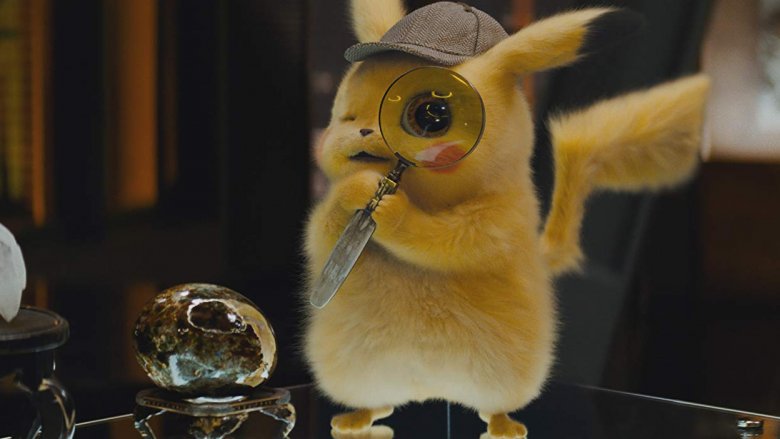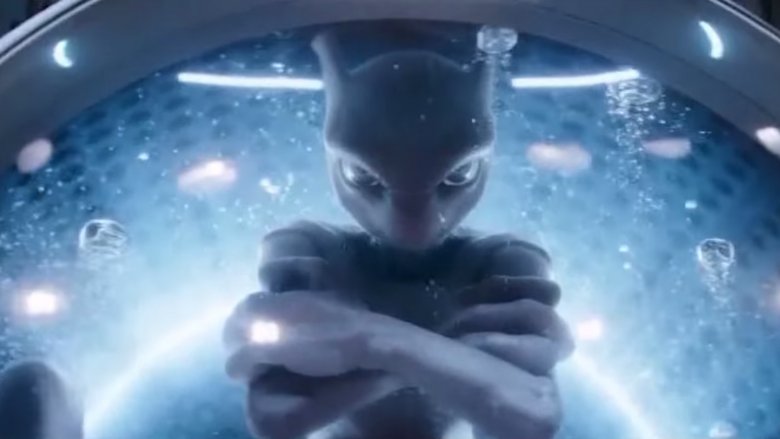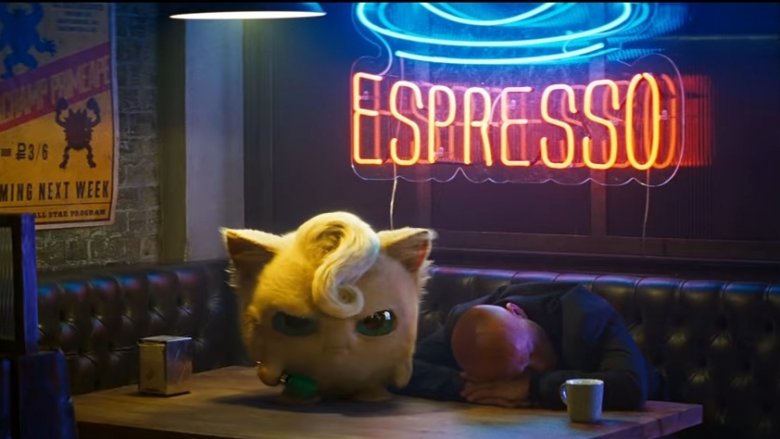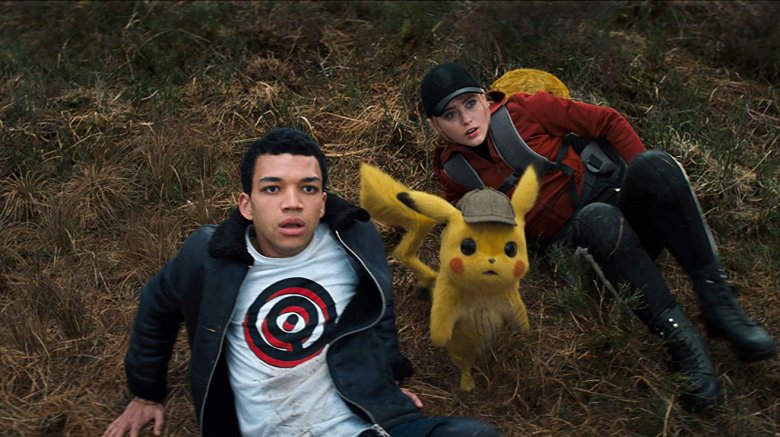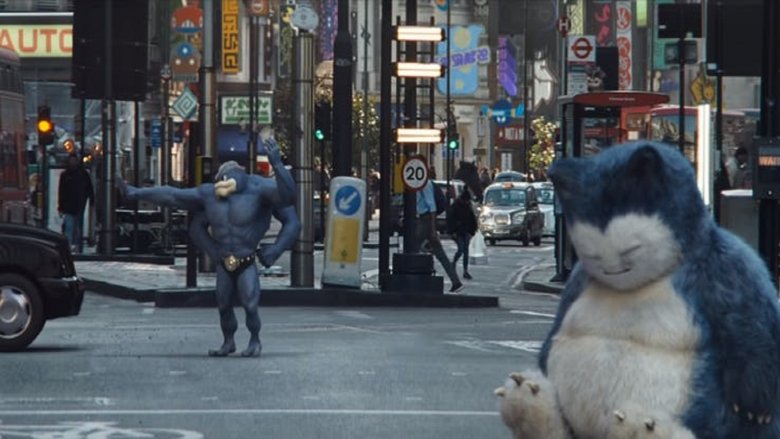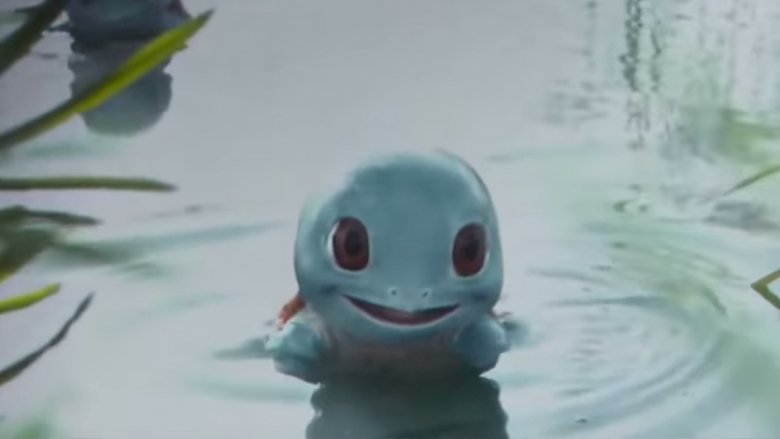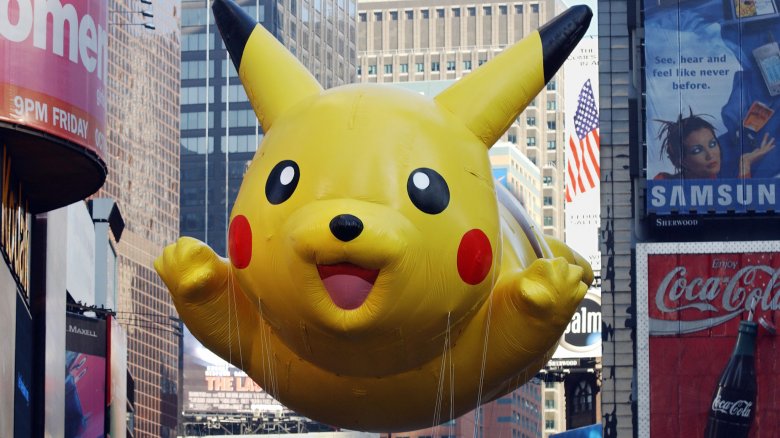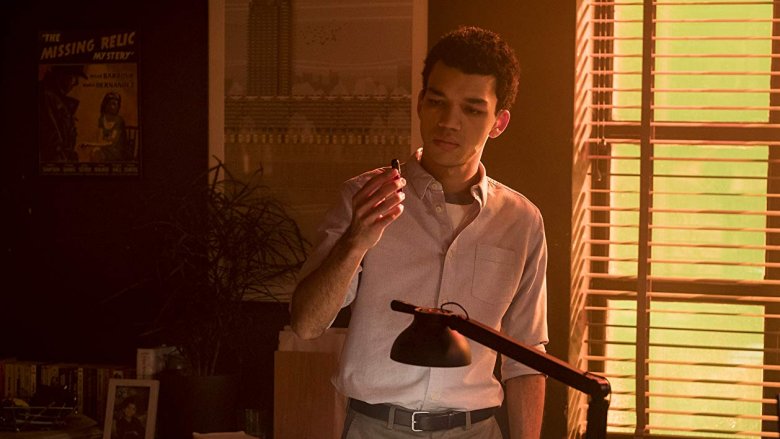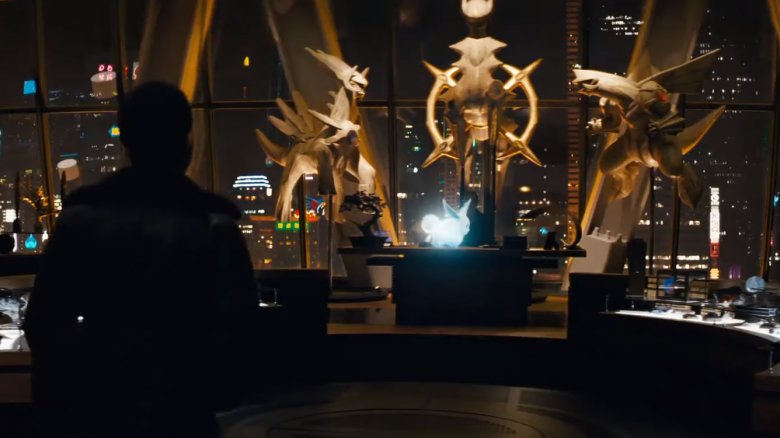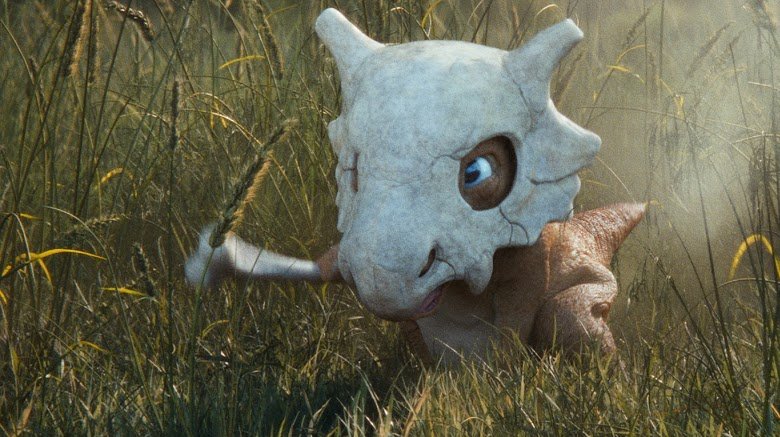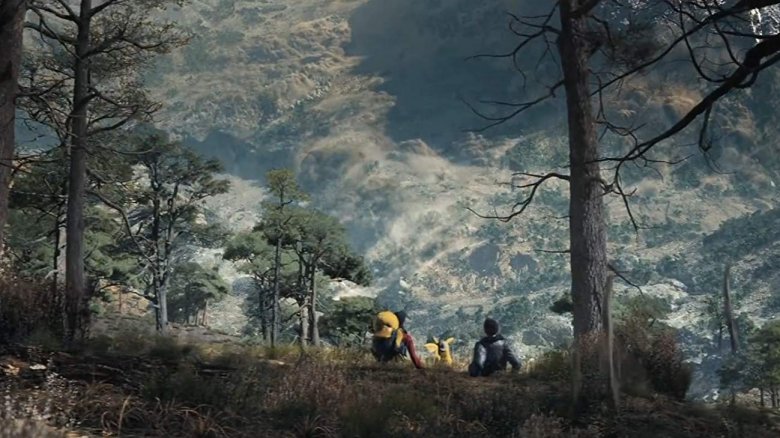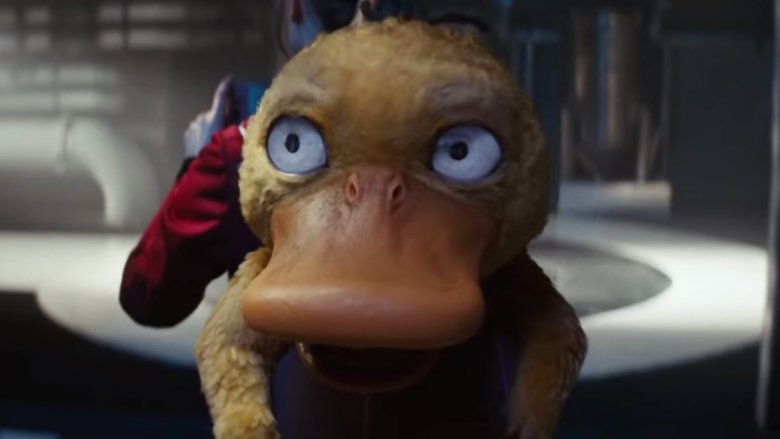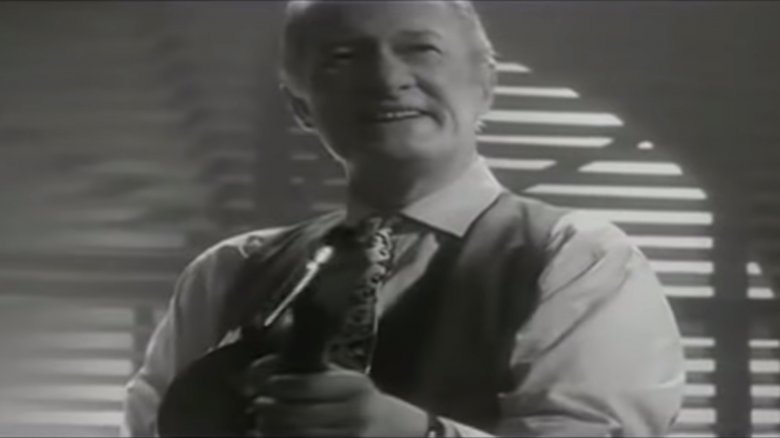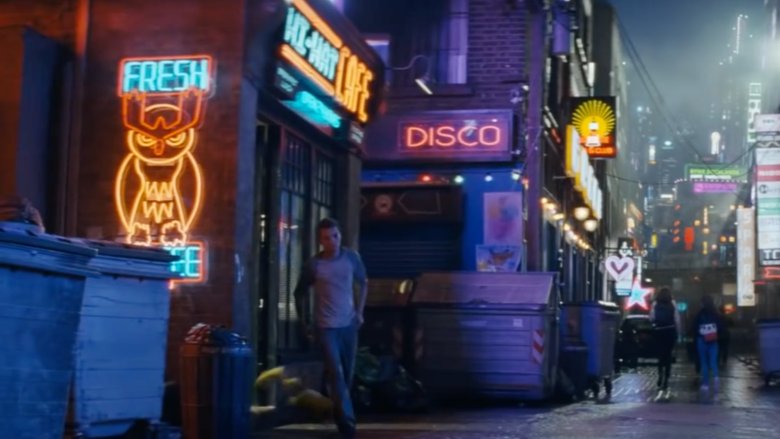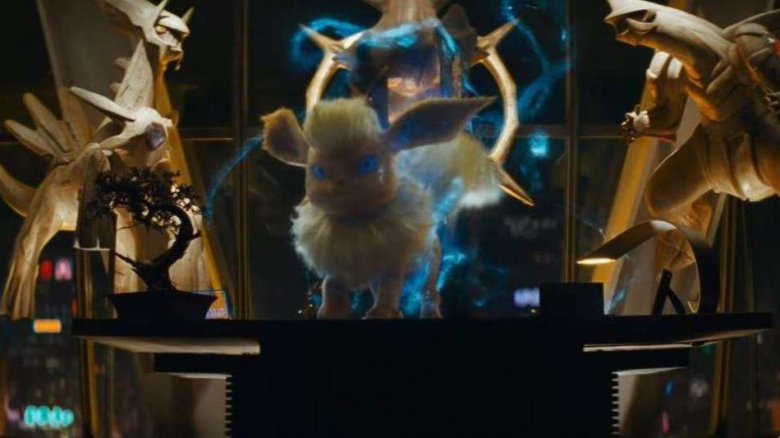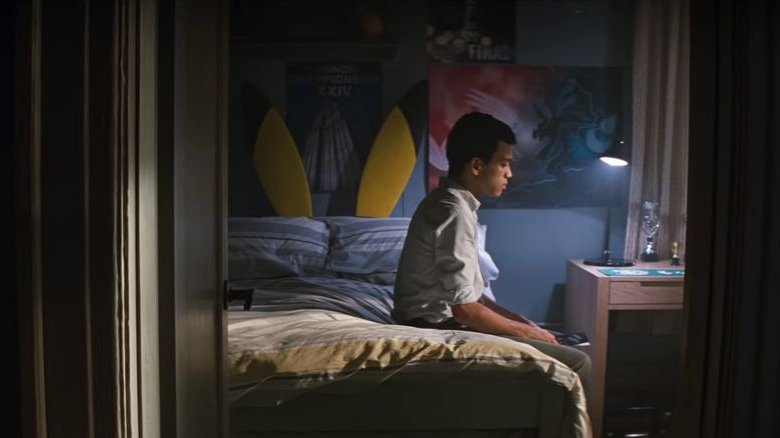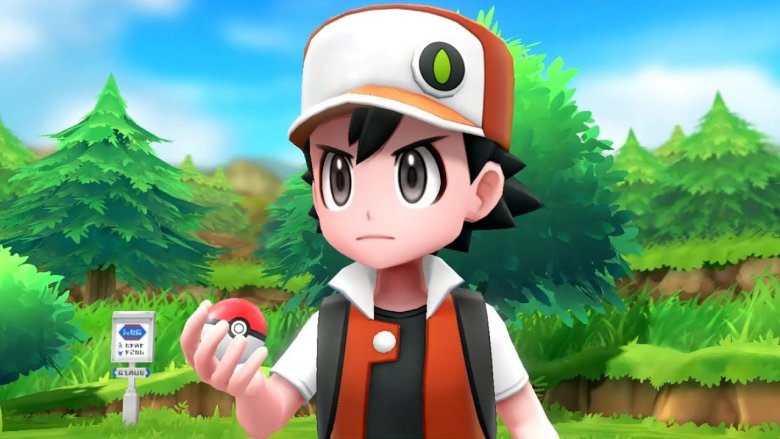Details You Missed In Pokemon Detective Pikachu
In 2016, Detective Pikachu was released for the Nintendo 3DS. The game focuses on Tim Goodman, a child who partners with a talking Pikachu to find his missing father and solve mysteries in Ryme City. Though wildly different from any previous titles in the Pokémon franchise, Detective Pikachu was met with relatively positive reviews.
After three years, the film adaptation of Tim and Pikachu's story has finally arrived on the big screen, starring Justice Smith as Tim and Ryan Reynolds as the voice of his wisecracking, caffeine-addicted sleuthing Pokémon companion. Although the movie's story is loosely inspired by the game, it's really more of a launchpad into a bizarre neo-noir world where humans coexist alongside a colorful menagerie of (sometimes disturbingly) realistic Pokémon creatures, topped off with the type of rapid-fire humor Reynolds fans will recognize from his portrayal of the mouthy mercenary Deadpool.
For fans of the Pokémon series, Detective Pikachu is filled with plenty of nods to the wider Pokémon universe. Some of these smaller references are easy to miss, so to help you keep track of them all, we've put together this list of some of the finer details that might have slipped past you in Detective Pikachu.
Similarities to 'The First Movie'
In the film, it's revealed that the Pokémon known as Mewtwo was captured before the events of Detective Pikachu — and was able to escape human captivity 20 years prior to the events in the film. This is likely an allusion to the first Pokémon film, appropriately titled Pokemon: The First Movie, which made its North American premiere on November 6,1999.
The First Movie centers around Mewtwo's origin story, beginning with its creation in a lab on New Island. Eventually, Mewtwo escapes and subsequently destroys the entire lab in his rage, but by the end of the film, it's shown that not all humans are bad and goes off to live in peace.
Though Detective Pikachu doesn't focus primarily on Mewtwo and its origin, the parallels are abundant. In this film, Mewtwo is captured, experimented on, and subsequently breaks out, similar to Pokemon: The First Movie. In both versions the lab is left in shambles, and Mewtwo slowly comes to believe that humans aren't inherently evil.
Jigglypuff's sleep-inducing singing
Throughout the Pokémon universe, Jigglypuff is known for its ability to lull people and other Pokémon to sleep when it sings. In the games, Jigglypuff's ability is pretty straightforward: You use its singing to force the opponent to sleep while you attack. However, Jigglypuff and its singing ability plays a bit of a bigger role in the Pokémon anime.
In the animated series, Jigglypuff's singing is often used as a joke that inconveniences the main characters and makes them fear this balloon-like Pokémon whenever it appears. In several episodes, the Pokémon performs for the main characters, only for them to inevitably fall asleep. Upset that no one listens to its song, Jigglypuff becomes angry and draws ridiculous images on the faces of its sleeping audience.
Referencing Jigglypuff's demonstrated abilities, Jigglypuff makes a brief appearance in Detective Pikachu. When Tim and Pikachu visit a cafe, a Jigglypuff is seen singing to another patron as he sleeps on the table. Just as in the anime, Jigglypuff puffs up, obviously upset that its song is once again ignored.
Unown graphic tees
Unown are unique Pokémon that resemble the Latin alphabet. The Pokémon species has 28 total different forms, with 26 of them each resembling a letter of the alphabet. Additionally, there are two other Unown forms representing an exclamation point and a question mark that were added in the third generation of Pokémon games. With so many different variations, it's not much of a surprise that at least one would make its way into the film.
While an actual Unown doesn't make an appearance in Detective Pikachu as a creature living in the world, the Pokemon finds indirect representation in the form of two shirts worn by Tim throughout the film: one with the O form and one with the H form.
In the world of Pokémon, different Pokédex entries say the Unown are connected with ancient hieroglyphics, and that when several gather together, they share a mysterious power. Aside from those two observations, very little is known about this specific species of Pokémon. Maybe that's a story for Detective Pikachu 2: Electric Mouse Boogaloo.
Snorlax blocks the road
In many of the Pokémon games, a common roadblock for trainers is a giant Snorlax sleeping in the middle of the road. These giant Pokémon require a special item known as the Poké Flute to awaken them, resulting in the player going on a quest for the item before being able to progress to a new area in the game. Snorlax has also appeared in the Pokémon anime as well, notably in the episode Wake Up Snorlax! in which a sleeping Snorlax blocks a water source from flowing into a nearby town.
Needless to say, Snorlax has been an obstacle throughout Pokémon, and this trend of Snorlax inconveniently blocking roads continues in Detective Pikachu. In one particular shot after Tim first arrives in Ryme City, a Snorlax can be seen sleeping in the road as drivers try to navigate around it. While the Snorlax is only shown for a few brief moments, for fans of the games, its inclusion is a fun callback to many players' first interaction with the sleepy Pokémon.
The squirtle squad
In an early episode of the anime titled "Here Comes the Squirtle Squad," a group of mischievous Squirtles play pranks on passersby, going so far as to dig pitfalls for unsuspecting travelers to fall into. Eventually, the group of Squirtles learn the error of their ways and give up their antics. Later on, in the episode "The Fire-ing Squad!," after leaving behind their childish pranks, the group of Squirtles work with firefighters in an official capacity and even participate in a firefighting competition.
A small allusion to the Squirtle Squad is shown during the promotional video that plays for Tim as he takes the train into Ryme City. As the narration describes a city where humans and Pokémon work together as equals, a group of Squirtles is shown onscreen working in tandem with firefighters from Ryme City as they put out a fire while the narration for the promotional video continues.
Pikachu parade floats
In the film, Ryme City is preparing for its 10th anniversary parade. As the parade commences, groups of people walk with their Pokémon partners and hold large parade balloons that are made in the likeness of several Pokémon. One of the most prominent balloons is the parade balloon of Pikachu himself.
What fans may not have noticed is the similarity between the balloon used in the film and the balloon used during the 2006 Macy's Thanksgiving Day Parade held in New York City. Because the series debuted in Japan in 1996, the Pokémon Company and Nintendo celebrated the franchise's 10th anniversary in 2006 with a newly designed float in the parade.
The first Pikachu balloon used in the parade was introduced in 2001, and featured a Pikachu that was based off the design of the Flying Pikachu Pokémon card illustrated by Tashinao Aoki.
Tim's trading card collection
Inside Tim's room is an array of Pokémon memorabilia, but most interesting is his collection of Pokémon trading cards. While we don't get to see much of his collection, we see Pikachu look through a binder obviously harboring Tim's card collection. As Pikachu flips rifles through the pages of the binder, it's plain that Tim, at least at one point in his life, was an avid collector.
Pokémon trading cards form the basis of a popular game in which a player builds a deck of different cards representing different Pokémon, items, trainers, and types of energy. The game has seen dozens of different expansions over the years, introducing new cards into the game. A version of the game was even brought to the Game Boy Color in 2000.
By illustrating Tim's interest in the game, Detective Pikachu shows his former dreams of becoming a Pokémon trainer, something he adamantly denies throughout the film.
Sinnoh legendaries
In the course of trying to discover the whereabouts of Tim's father, Tim and Pikachu are invited to the office of Howard Clifford, the creator of Ryme City. Though they're there to receive information crucial to finding Tim's father, as the duo enters the office and approaches Howard, three statues of the Pokémon Palkia, Dialga, and Arceus can be seen behind his desk.
These three are noteworthy because they're the legendary Pokémon from the fourth generation of games: Diamond, Pearl, and Platinum. According to the Pokédex in Pokémon Pearl, "It is told in mythology that [Arceus] was born before the universe even existed." Being the creator Pokémon, Arceus created Palkia, who was given power over space, and Dialga, who was given control over time. The story of Arceus and how it created the world parallels the story of Howard Clifford creating Ryme City, a place where humans and Pokémon can live together in harmony as equals without Pokéballs or Pokémon battles.
Cubone's cries for its mother
At the beginning of the film, Tim's friend Jack takes him out to a field in a futile attempt to make him capture a Pokémon that will become his partner. To do this, Jack has arranged for Tim to find a Cubone, thinking that his friend will form a special bond with it on account of the Pokémon's lonely nature. When the two encounter the Cubone, it's crying alone, and Tim points out that the Pokémon is wearing its mother's skull, a reference to one of the more disturbing pieces of lore from the games.
According to the Pokédex entry for Cubone in Pokémon Stadium, it "always wears the skull of its deceased mother on its head and never shows its face. It cries mournfully in the moonlight." In the first generation of Pokémon games, there's even a portion of the story devoted to dealing with the ghost of Cubone's mother.
Since Tim lost his own mother as a child, it makes sense why Jack might think that the two would get along.
Giant Pokémon reference with Torterra
As Tim and Lucy escape from the lab where Mewtwo is being held, they run through a small enclosure with supposedly giant Torterra inside. They soon come to realize that they have indeed stumbled upon the home of several mile-wide Torterras after the gargantuan Pokémon stand up, causing rockslides and earthquakes.
The giant turtle Pokémon featured in Detective Pikachu are not the first excessively large Pokémon to make an appearance in the Pokémon universe. There have been several unusually large Pokémon in the anime, but arguably the most memorable showed up in episode 17, fittingly titled "Island of the Giant Pokémon." In the episode, series protagonists Ash, Misty, and Brock are trapped on an island and separated from their Pokémon. As the small group looks for their furry friends, they run into various giant Pokémon that attack them and wreak havoc.
Other episodes have featured giant Pokémon as well. Season 2's "The Ancient Puzzle of Pokémopolis" features a giant Alakazam and Gengar Pokémon with strange markings on them, and "Gulpin it Down" from season 7 features a giant Treecko and Gulpin. Aside from a cool set piece, the giant Torterras in Detective Pikachu are a nifty nod to the history of the show.
Psychic Psyduck
It may not seem outwardly threatening, but Psyduck harbors a dangerous secret. In Detective Pikachu, Lucy's Psyduck is apparently so dangerous that Pikachu refers to it as a ticking psychic bomb that can go off at any moment when its headaches aren't managed.
This isn't the only mention of Psyduck's psychic abilities across the Pokémon franchise. For instance, in the Pokémon anime, Misty owns a Psyduck that is often perceived as useless, and she often takes her frustrations out on the dense creature. However, despite being a bit dopey, Psyduck has saved the day on multiple occasions with its headaches and resulting display of psychic powers.
The Pokédex entry for Psyduck from the game Pokémon Moon describes the Pokémon as being "troubled by constant headaches" and adds, "The more pain it's in, the more powerful its psychokinesis becomes." While Psyduck in the games can learn psychic moves as they grow stronger, Detective Pikachu keeps with the anime's tradition of making the creature's latent mental power innate.
Keep the change, ya filthy animal
As Tim enters his father's apartment to get his affairs in order, one of the first things he notices is that the television in the living room is turned on. Though Tim dismisses the movie, saying that his late father always loved detective films, many viewers will be able to recognize the snippet playing on the television from another popular film.
The clip playing looks like it's from the pre-color era, but it was really filmed for a scene from the 1990 Christmas film Home Alone. In an interview with Fresh Fiction, Detective Pikachu director Rob Letterman told the story of how the not-as-old-as-it-looks clip made it into the film.
"It was always scripted there was some film noir-y, detective film there," he explained. "Just as a laugh, we got the movie that they shot for Home Alone off of YouTube at some point and used it as a temp. We could never beat it! It got to the point of it being 'Well, why not try to license it?' We got it cleared, miraculously, and it became this funny inside joke just to us."
Noctowl Cafe
In one scene, Tim and Pikachu visit a diner called the Hi-Hat Cafe. For fans of the Pokémon series, the all-night establishment features a familiar face on the building's facade: a neon sign of Noctowl, the owl Pokémon. Noctowl first appeared in the second generation of Pokémon titles, and its introduction into the Pokémon series is notable because night and day cycles were also first introduced in the second generation games, adding a new layer of gameplay. The new feature made certain Pokémon strictly available at certain times of the day; Noctowl is one of these unique Pokémon, only appearing at night in the wild.
For a cafe open late at night, Noctowl serves as the perfect mascot, and the neon sign featuring its likeness is the most fitting tribute to one of the franchise's most lovable insomniacs.
Eevee and Evolution Stones
When Tim and Pikachu first visit Howard Clifford's lab, an Eevee is sitting on his desk. Shortly after the duo approaches, the Eevee evolves into Flareon. Eevee's sudden transformation indicates that Howard is in possession of Evolutionary Stones, specifically a Fire Stone.
Eevee is one of the most unique Pokémon in the franchise. Unlike other creatures that can evolve into one or two Pokémon depending on the situation, Eevee can evolve into one of eight different Pokémon. In the first generation of games, Eevee can evolve into one of three Pokémon: Flareon, using an item called a Fire Stone; Vaporeon if given a Water Stone; or Jolteon if given a Thunder Stone. The second generation of games adds two Eeveelutions. If the Eevee has a good friendship level with its trainer, it can evolve into Umbreon at night or Espeon during the day. In generation four, Eevee can also change into a Leafeon or Glaceon if the Eevee evolves in a specific location with either a Moss Rock or Ice Rock, respectively. Finally, in generation six, Sylveon is added to the mix, evolving if it learns a fairy-type move.
While there are other other Pokémon that can evolve through other evolution stones, Eevee's unique ability to take advantage of these items has made it a fan favorite. By showing the evolution, Detective Pikachu showcases one of the franchise's most beloved Pokémon as well as its unique ability.
Tim's Pokémon posters
From Pokémon trading cards to giant Pikachu ears at the head of his bed, Tim's room is full of Pokémon references and memorabilia. Though not every Pokémon makes an appearance in Detective Pikachu, a decent amount can be found hanging on Tim's bedroom walls.
A handful of Pokémon from Red, Green, Blue and Yellow like Dragonite, Articuno, Hypno, Blastoise, and Charizard all appear on posters in Tim's room. The Pokémon Steelix is the only representation for generation two's Silver and Gold Pokémon games, but the third generation of games, Ruby, Sapphire, and Emerald, are represented by posters of the Pokémon Latios, Latias, and Rayquaza. In terms of the fourth generation's Diamond and Pearl titles, a poster for the Sinnoh Championship XXIV is also present. Additionally, two of the fifth generation games, White and Black, are represented by the Pokémon Reshiram and Zekrom, who are shown facing off against each other.
While the appearances are brief, these posters allow for small cameos of Pokémon that aren't seen walking around Ryme City in the rest of the film.
Trainer Red
In the informational video that plays while Tim rides to Ryme City, a familiar face makes a short cameo. Howard mentions Pokémon battles as two opponents meet in an arena filled with cheering fans. The trainer onscreen, clad in red and wearing a signature baseball cap, resembles the Pokémon trainer Red, the hero from the first generation of Pokémon games.
Red is the official name of the protagonist in Pokémon Red, Green, and Blue. In Pokémon Gold, Silver, and Crystal, Red is a powerful trainer that defeated the criminal group known as Team Rocket three years prior, causing the criminal group to disband. After disrupting Team Rocket's plans and becoming the Pokémon League Champion, Red retreats to Mt. Silver to train his Pokémon team. He serves as the final boss for the player to defeat and is the strongest opponent in the game.
Though other trainers may have high leveled Pokémon and diverse teams, Red stands apart as the franchise's first superstar trainer. This short visual callback is enough to spark a pang of nostalgia for those familiar with the character and his legacy.
